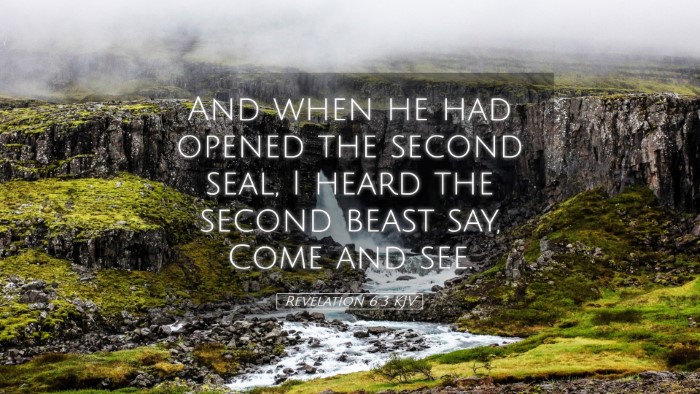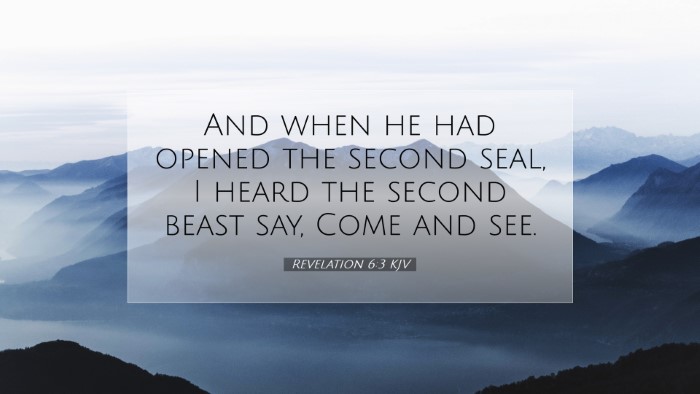Commentary on Revelation 6:3
Verse Text: "And when he had opened the second seal, I heard the second beast say, Come and see." (Revelation 6:3)
Introduction
The verse in focus, Revelation 6:3, marks a pivotal moment in the apocalyptic narrative of John's vision. Here, the opening of the second seal initiates a series of events that unveil God’s plan for judgment and redemption. The image of the beasts and seals carries profound theological significance, reflecting God’s sovereignty and the unfolding of His eschatological purposes.
Overview of Revelation 6
This chapter opens the series of seals that are connected to the unfolding of end-times events. It frames the narrative with vivid imagery and helps to establish a theology of suffering and hope in the face of impending judgment.
Contextual Background
Revelation, attributed to the Apostle John, was written during a time of great persecution for early Christians. The symbols and metaphors serve to provide both warning and encouragement amid tribulation. The seals represent situations and events that will occur as God reveals His purposes concerning humanity.
Commentary Insights
Matthew Henry's Perspective
Matthew Henry emphasizes the transition between seals as representing phases in God’s judgment. He notes how the opening of each seal unveils a specific aspect of the human condition and divine response. In Henry’s view, the second seal introduces a significant military conflict, symbolized by the rider on the red horse, who represents strife and bloodshed. This bloodshed is an extension of the first seal's conquest, demonstrating how human ambition leads to conflict.
Albert Barnes' Interpretation
Albert Barnes discusses the implications of the second seal and its connection to the struggle among nations. He observes that the phrase "Come and see" invites the reader into a vision of devastating realities. Barnes points out that the opening of the second seal represents God's authority over the events of history, and it serves as a narrative device that compels the audience to engage more deeply with the text. The emergence of a red horse, indicating war, signifies the somber truth that conflict is often a manifestation of divine judgment upon a rebellious world.
Adam Clarke's Analysis
Adam Clarke provides a nuanced understanding of the second seal, reflecting on the nature of the beast and the symbolic meaning of the red horse. He emphasizes the duality of God’s justice and mercy. Clarke posits that while the second seal represents war and turmoil, it simultaneously speaks to the ultimate victory of Christ over evil. The invitation to "Come and see" serves as a call to awareness of both the challenges and the assurances offered through faith in Christ, as the narrative weaves through themes of suffering and redemption.
Theological Implications
The second seal introduces essential theological themes that resonate throughout scripture. These include:
- The Sovereignty of God: The control God exercises over historical and eschatological events, fulfilling His divine plan amidst chaos.
- The Reality of Suffering: The introduction of war and conflict highlights the ongoing reality of human suffering and the consequences of sin.
- Divine Judgment: The unveiling of God’s judgment serves as a warning and reminder of accountability for human actions.
- Hope for Believers: Despite the grim reality of conflict, the overarching message remains one of hope, affirming God’s ultimate plan of redemption.
Practical Applications for Pastors and Scholars
This verse invites reflection on various themes relevant to pastoral ministry and scholarly study:
- Preaching on Judgment: Pastors may consider how to address themes of divine judgment with compassion, framing them within the context of God's redemptive purpose.
- Teaching on Suffering: An exploration of suffering as depicted in Revelation can provide pastoral care to congregants facing trials, helping them to see their struggles in light of God’s sovereignty.
- Eschatological Engagement: The significance of sealing events can lead to discussions on Christian hope in the face of societal unrest, fostering a deeper understanding of God’s faithful presence throughout history.
Conclusion
Revelation 6:3 serves as a poignant reminder of the complex interplay between divine sovereignty and human experience. By examining insights from Matthew Henry, Albert Barnes, and Adam Clarke, one finds a rich tapestry of theological reflection that speaks to the heart of the Christian faith. The verse invites believers into a deeper awareness of God’s unfolding plan—a plan utilizing both judgment and grace, with an emphasis on hope for those who remain steadfast in faith.


